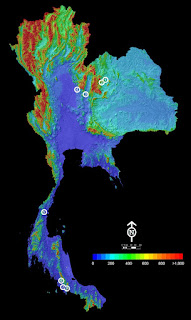 |
| Coecobrya whitteni Nilsai & Jantarit; C. troglobia Jantarit & Nilsai; C. ellisi Jantarit & Nilsai and C. phitsanulokensis Jantarit & Nilsai in Nilsai, Detcharoen, Godeiro & Jantarit, 2021 |
Abstract
Four new species of troglomorphic Coecobrya Yosii, 1956 are described from caves located in the central and northeastern regions of Thailand. Coecobrya whitteni sp. nov. and C. troglobia sp. nov. are from Khon Kaen province, C. ellisi sp. nov. is from Phetchabun province and C. phitsanulokensis sp. nov. is from Phitsanulok province. They all exhibit remarkable troglobitic characters i.e. elongated antennae, legs and furca, slender claw complex and large body size. Coecobrya whitteni sp. nov. is similar to C. troglobia sp. nov. and they were found a distance of only 3.4 km from each other. However, they are mainly different in the number of An mac on dorsal head and number of chaetae of Th. II. Likewise, C. ellisi sp. nov. is similar to C. phitsanulokensis sp. nov.. However, they differ in the number of An mac on the dorsal head, the number of central mac on Abd. II, central mac on Abd. IV, lateral mac on Abd. IV and the number of inner teeth of the claw. Moreover, C. ellisi sp. nov. has orange pigment dots on the body, a unique character, considering that all other troglomorphic Coecobrya species in Thailand are devoid of pigmentation. The results of the molecular approach based on two partial mitochondrial markers (COI and 16S rDNA) and a nuclear gene fragment (28S rDNA) supported the results of morphological species discrimination in separating the four nominal populations as valid species. An updated dichotomous key of Thai troglomorphic Coecobrya species is also given.
Keywords: DNA barcoding, Entomobryinae, molecular phylogeny, subterranean habitat, troglomorphy
Class Collembola Lubbock, 1873
Order Entomobryomorpha Börner, 1913
Family Entomobryidae Schäffer, 1896 sensu Zhang et al, 2019
Subfamily Entomobryinae Schäffer, 1896 sensu Zhang and Deharveng 2015
Genus Coecobrya Yosii, 1956
Coecobrya whitteni Nilsai & Jantarit, sp. nov.
Etymology: Coecobrya whitteni sp. nov. is named in honor of the late Tony Whitten in appreciation of his enormous contributions to the discovery and conservation of karst and cave invertebrates across Asia.
Coecobrya troglobia Jantarit & Nilsai, sp. nov.
Ecology: Coecobrya troglobia sp. nov. is restricted to the dark zone of the cave, where it was found in two chambers in an oligotrophic environment. Most individuals were found on the floor, on stalagmites and on the rock walls. The temperature in the dark zone was 21.4–23 °C and the relative humidity was about 75 %.
Etymology: The name of the new species is derived from the Greek stem “trogle (τρώγλη)” which means “hole”, referring to the habitat of this new species which is restricted to the subterranean environment.
Coecobrya ellisi Jantarit & Nilsai, sp. nov.
Etymology: This species is named in honor of Martin Ellis, a British speleologist who played a role in the Tham Luang cave rescue in Thailand (in 2018), and for his outstanding contribution to the study of cave fauna in Thailand. Our biological surveys have benefited tremendously from his support, including the discovery of this new species.
Coecobrya phitsanulokensis Jantarit & Nilsai, sp. nov.
Etymology This species is named after the type locality, Phitsanulok province, where the material was collected.
Areeruk Nilsai, Matsapume Detcharoen, Nerivania Nunes Godeiro and Sopark Jantarit. 2021. Four New Species of Troglomorphic Coecobrya Yosii, 1956 (Collembola, Entomobryidae) from Thailand based on Morphological and Molecular Evidence, with An Updated Key of Thai Troglomorphic Species. Subterranean Biology. 41: 1-42. DOI: 10.3897/subtbiol.41.76926




